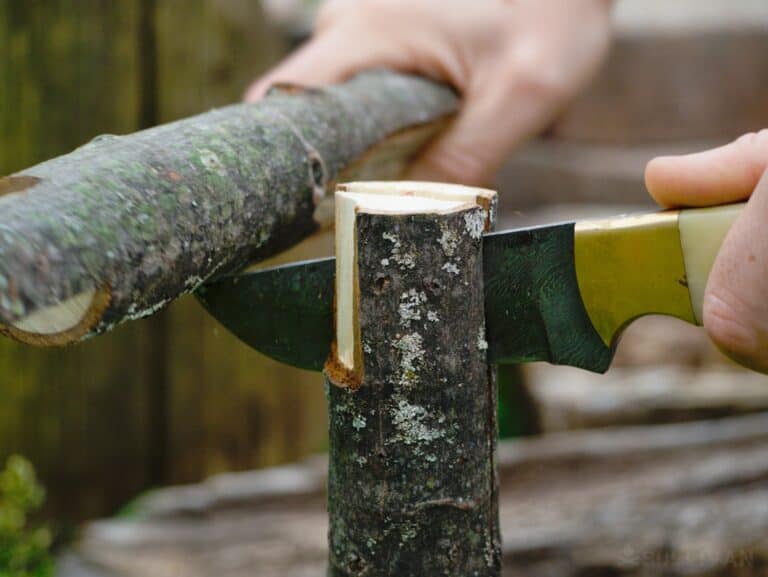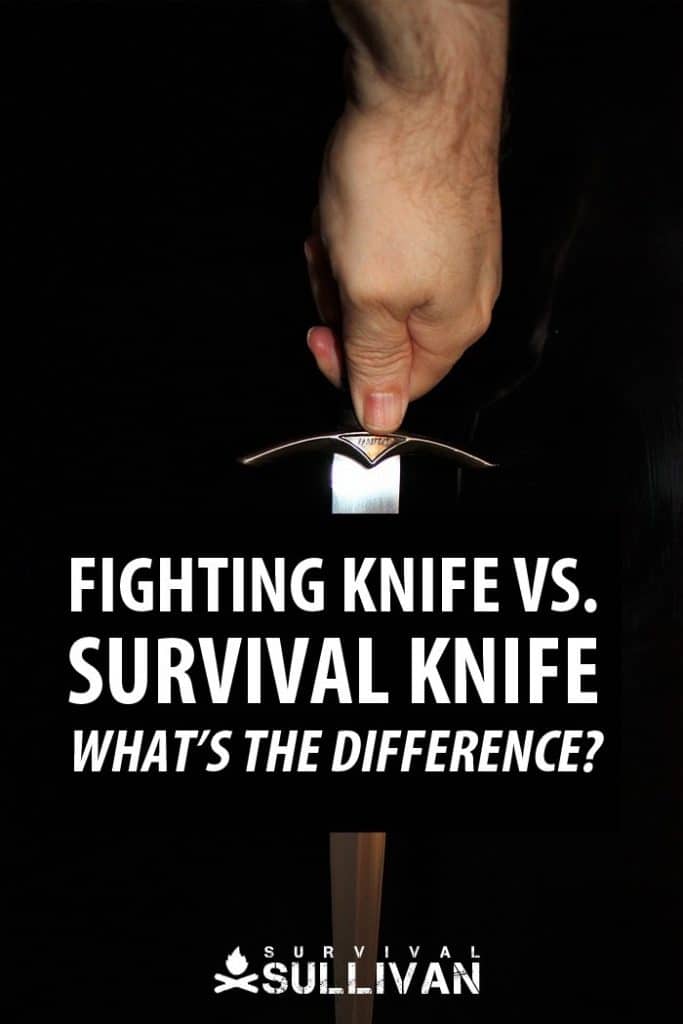You’ll never see preppers fuss more than they will over gear and its definitions. Some folks are just pedantic slaves to nomenclature, like your author here. Why is that? ‘Cause words mean things.
Case in point: knives for prepping. Is a fighting knife a knife you happen to have for fighting or a knife designed to be good at fighting? Same thing with a survival knife. Should a prepper care which one they get so long as they have a knife for prepping? Just what’s the difference?!
A fighting knife is designed for fighting, typically with an aggressively textured handle shaped to lock into the hand, a half or full guard, and a blade designed for maximum sharpness and penetration . A survival knife is designed for a variety of tasks but predominately the processing of wood, skinning of game, and other assorted chores.
Well, which one is best for a prepper?
The answer is always “it depends,” reader. There is no Best for One and All knife. If I was in an urban environment where I would be more worried about slashing a stuck seatbelt off of me or opening up some dirtbag trying to mug me or my wife, I’d want the typically lighter, leaner fighting knife.
If I knew I was heading into deeper country, I’d want the survival knife so I’d know I had a reliable tool for getting through wood (especially by batoning) and keeping its edge “sharp enough” to do work would be less of a concern than with the high-performance survival knife.
You can certainly do the work of one with the other: a survival knife will pierce a ribcage or open up someone’s guts nearly as easy as the fighting knife – it just won’t be optimized for the task.
A fighting knife can certainly handle the mundane chores of whittling wood and cleaning a fish- but it won’t be quite as durable or easy to use as the survival knife.
Your best bet for getting the knife you need is to evaluate what your most likely needs are based on your locale, anticipated situation and plan.
Fighting Knives for Social Scuffles
As I said, you’ll rely on a fighting knife for employing, ah, correction with those who intend to harm you and yours when you either don’t have a firearm or cannot safely employ it.
Most fighting knives are designed to be a little on the slender side, with pronounced, sharp points often engineered for strength and scary sharp blades, the better to help them lay open clothing and skin beneath.
A fighting knife is most often not a huge, scary chopper like a short sword- or machete-sized bowie, but instead is a modestly sized blade of 5” or so, long enough to reach the vitals from nearly any angle of entry on a thrust.
Disclosure: This post has links to 3rd party websites, so I may get a commission if you buy through those links. Survival Sullivan is a participant in the Amazon Services LLC Associates Program. As an Amazon Associate, I earn from qualifying purchases. See my full disclosure for more.
Any modern fighting knife of good make will be forged from quality steel and quite strong, but they are almost always of leaner design than a survival knife.
This means they won’t hold up quite as well as a survival knife when the time comes to subject it to “destructive” use like batoning wood or prying open a crate or lock.
This is not to say some of the best steels out here won’t hold up and pass such a trial with flying colors- they most likely will- but geometry counts for a lot, and a fighting knife is comparatively delicate compared to a survival or “field” knife.
Fighting knives are designed and intended for, yep, fightin’ and that means some of their features may make them entirely unsuitable for other uses.
Take a look at the classic tapering shape of a double edged dagger or stiletto and you’ll see what I mean. There is no way you’ll be able to safely baton such a knife, or choke up on it without destroying it!
Survival Knives for Tough Times
A survival knife on the other hand is the go-to option when you want to keep not only a knife but a few essential goodies with you on your pack or belt or in your vehicle.
The thick, heavy spines and conservative grinds on the blade of a survival knife means they have a little bit of axe DNA in them.
They can take a pounding and smile, and you’ll be able to apply a baton to them over and over without fear of rolling an edge, bending the blade or chipping it.

Points and edge configurations come in many styles and shapes, but a wide blade is common both for easier splitting and more standoff from the work piece.
Survival knives also work great for prying, scratching and digging using the tip under control; clip points, and drop points are very common on survival knives for just this reason.
Some survival knives even feature a full or partially serrated spine to enable you to saw with it. This makes batoning a little more challenging, but still possible.
A survival knife is more likely to be massive, akin to a machete, but this great size is not always an asset.
What it does afford though is an equally huge sheath and handle, the better to store copious amounts of survival items in like matches, sharpening stone, fishing line, snare wire, water treatment tabs, compass, map and more.
Now, the classic hollow-handled survival knife is almost always a bad idea. This type of handle, unless executed masterfully from top quality makers, almost always results in a great loss of strength; not a good play for a knife you plan to pound on. If you need or want a survival kit with your survival knife, get one that carries it on the sheath.
There You Have It…
Fighting and survival knives are certainly cousins on the blade family tree, but designed and optimized for very different tasks.
You can substitute one for the other in a pinch, and hybrids do exist, but taking a pure example of one or the other to the opposite’s side of the house is not a good idea. Take care to assess which type will serve you best before you commit to it.


Tom Marlowe practically grew up with a gun in his hand, and has held all kinds of jobs in the gun industry: range safety, sales, instruction and consulting, Tom has the experience to help civilian shooters figure out what will work best for them.

Not all survival knives have to be “massive”. There are actually two common classes of survival knives. “Field” knives are the bigger ones (9-12″ blade), better for chopping tasks and some defensive tasks (particularly dangerous animals), and “bush” (4-6″ blade) knives better for most other tasks.
a survival knife for me, I intend to do a lot of surviving and not much(none in fact) fighting.
Sounds good. But, although you don’t intend to do any fighting, you might HAVE to fight sometime because you might be attacked. So, consider having both, or a hybrib. “Be prepared”, as the Boy Scout motto says. I respect that motto. I don’t know what, if anything, the coed-scouts say about it.
Say there, why not have one of each, as long as that doesn’t cause a weight and/or space problem? And, if you don’t live in a big city nor out in the rural countryside, but in the suburbs or ‘exurbs’ or a small town, maybe one of each would be good, or maybe a hybrid.